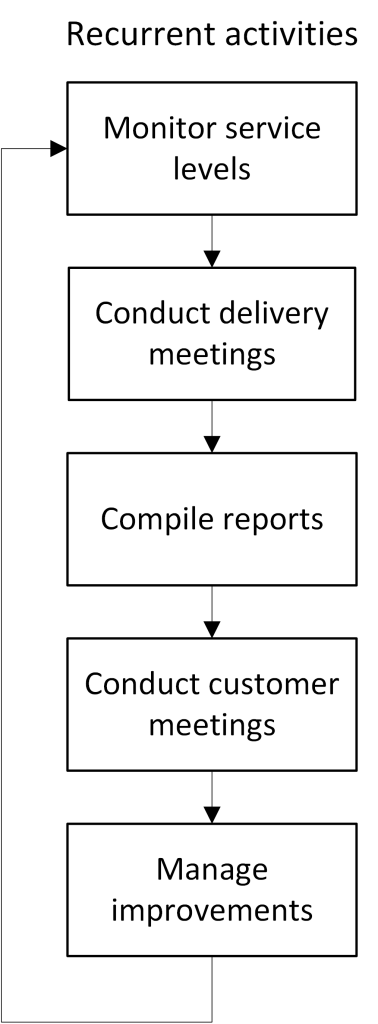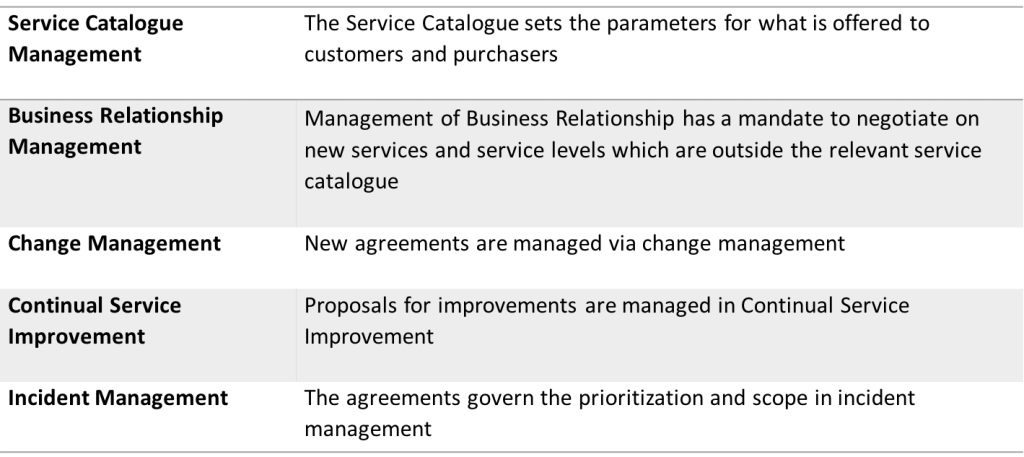In order to ascertain whether the delivery of IT services to the business is satisfactory or unsatisfactory, the agreed levels must be defined and measured. Without defined levels, the business does not know what can be expected and the IT supplier does not know the level at which it should deliver. The result can then be that the business expects miracles, which leads to disappointment and a general perception that the IT department is not doing what it should. The IT department then risks ending up in the situation that the person who shouts loudest is prioritized first, instead of having defined priorities based on the business’s actual requirements.
Service Level Management is the process that defines, documents and follows up the delivery of IT services to the business.

Purpose
The purpose of the process is to ensure that there is a clear, common starting point for which service levels can be expected for the IT services and what should be delivered.
This is achieved through:
- Identifying, defining, documenting, monitoring and reporting the service levels
- Ensuring that the customers have the right expectations for the service levels delivered
- Ensuring that service levels are measured and that proposals for improvement are initiated
Scope
Service Level Management comprises the entire delivery of IT services to the business.
This includes:
- Administering the agreements that are drawn up with the business. All deliveries should be measured and followed up together with customers and purchasers
- Coordinating the delivery of supporting services concerned and ensuring that they are produced at least the service levels that are set in the agreements with the business
- Initiating and driving proposals for improvement based on the agreements that are drawn up with the business
- Representing and taking responsibility for the entire delivery of IT services in relation to customers and purchasers
Value for the business
Service Level Management provides a structured contact point for all services delivered to the business, which makes it simpler and more efficient for customers and purchasers. If agreed levels are not achieved, the process supplies status information to the customers and also initiates improvement measures.
Agreements
Service Level Management must formulate a structure for agreements that suits the customers and in line with the structure within the organization. This is only done once, and then applies for all agreements.
There are three different variants of agreements:
- Service-based agreement – An agreement based on a specific service and that applies for all customers
- Customer-based agreement – An agreement based on a specific operation and which contains all services that the customer uses
- Overall agreement – A combination of levels in the business. For example, an agreement that applies for the customer’s entire organization can be drawn up, combined with specific agreements with each purchaser that regulate the unique delivery to the part of the business
An agreement should contain all information that is necessary so that it is clear which IT services are delivered and at which service levels. An example of content is:
- Introduction
- Purpose
- Contacts
- Forms of cooperation
- IT services included
- Service levels
- Service window
- Continuity planning
- User support
- Escalation procedures in the business
Activities
The activities in the process are divided into those which manage new agreements and that are performed for each new delivery, and those which manage recurrent assignments.
The following activities apply for new agreements:
Identify the delivery – This is performed together with the customer or the purchaser and is documented in a Service Level Requirements document. It comprises documentation of which IT services are delivered and which expectations there are of the service levels.
Evaluate the delivery – The first time a customer or purchaser performs these activities it is easy for the service levels requirements to exceed what the IT department delivers. It is therefore important to separate that which is within the framework of the current delivery and what are requests for new services or other service levels. All requests that are not in the relevant service catalogue should be managed as improvement proposals and be sent onward to the Business Relationship Management process for further processing.
Document agreement – The agreed services and levels are then documented and managed via Change Management and Release Management to ensure correct implementation in the IT organization. It is important not to include service levels outside the relevant service catalogue, as this creates incorrect expectations in customers and purchasers.

The following activities are recurrent:
Monitor service levels – Continuously monitor the delivery of IT services and their service levels with the assistance of Service Desk, Technical Management and Application Management functions.
Conduct delivery meetings – The IT services that are delivered are made up of supporting services in accordance with the service structure described in the Service Catalogue Management chapter. Each supporting service is represented by a service owner within the IT organization. Establish a forum within the Delivery Management function and hold meetings with the service owners concerned. At these meeting, the specific delivery is analyzed and proposals for improvement are prioritized and implemented in accordance with the Continual Service Improvement process.
Compile reports – Produce reports on service levels delivered in accordance with the DIKW model, as described in the Knowledge Management chapter. Also include analyses of major incidents performed, and which affect the customer. If improvement activities are in progress, these should also be included in the report.
Conduct customer meetings – The reports constitute the basis for the ongoing meetings held with customers and purchasers. The aim of the meetings is to check the agreed delivery, but can also include expansion or reduction of the delivery. These meetings are often the only recurrent meetings that the customers and purchasers have with the IT department, which means that all types of questions can be addressed. If that is the case, deal with the question and then convey it internally to the right body. Where questions are announced in advance, if necessary, other roles that are involved can participate in the meeting.
Manage improvements – Service Level Management should be proactive in building confidence for IT in the business. Most customers and purchasers understand that the IT department sometimes fails in its delivery of IT services. However, confidence is largely based on errors being rectified rapidly and the delivery being continually improved. Initiate proposals for improvements through the Continual Service Improvement process.

Documentation
All documentation included in Service Level Management should be in the customer database. The documentation is included in the overall knowledge database as described in the Knowledge Management section.
The following documentation should be located within the framework of Service Level Management:
- Agreements containing services and service levels
- Common cooperation procedures
- Minutes from meetings
- Documentation of planned and ongoing improvement activities
- Reports of service levels delivered
Relationships with other processes and functions
Service Level Management has links to many other processes. The most common are listed here:

Trigger
The process is triggered through one of the following:
- Changes in the service catalogue
- New deliveries to the business
- New or changed agreements
- The IT organization not achieving the agreed service levels
- Meetings with customers and purchasers
Input
The following inputs are needed for the process:
- Information about the customer structure
- The service catalogue
- Documentation about supporting services
- Measurement data from the delivery of IT services
Output
The following outputs are generated by the process:
- Service level reports
- Proposals for improvement
- Agreements
- Minutes from meetings with customers and purchasers
Measurement
The following measurements can be made of the process:
- Number of improvement activities implemented
- Percentage of customers that have agreed service levels
- Percentage of customers that have regular meetings
Challenge
The following elements need specific attention when implementing Service Level Management:
- Lack of experience of businesslike relations between IT and the business can mean that the requirements for service levels are not realistic
- The roles of customer and purchaser are not properly embedded in the business, which means that the IT department needs to harmonize and coordinate different requirements from the same operation

